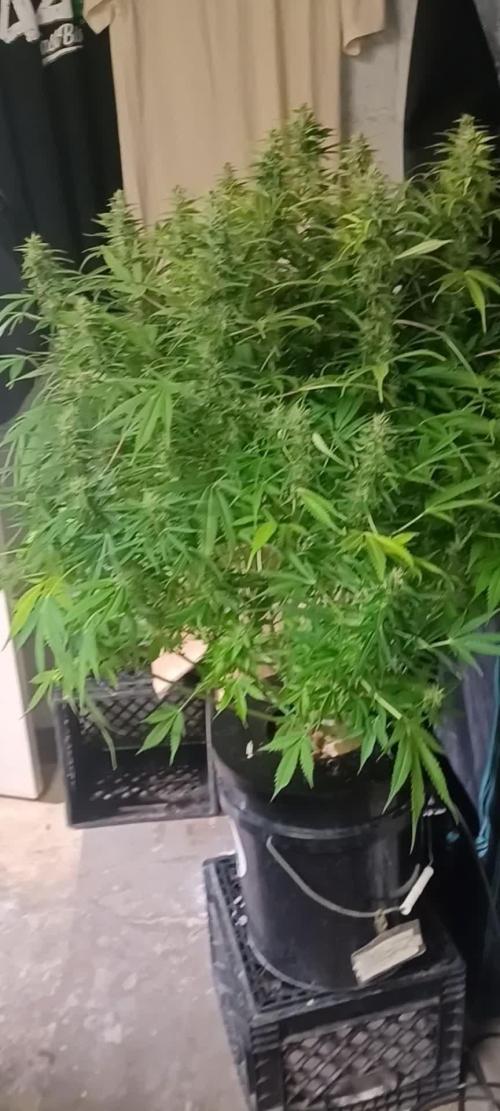The Grow Awards 2026 🏆 



































Likes
Comments
Share


@GreenHouseLab
Follow
In the final week, highly resinous flowers that I cannot wait to sample from the 3 phenos. Had more pics and vids but the site won’t let me upload.
Hope everyone has a great week!
GHL
Likes
29
Share


@SalocinSpecial
Follow
***Note that I started to count the days when I placed the seeds between paper towels. The seeds were planted 3 days later and sprouted from the ground 2 days after being planted.
D80 (13/05/2021): I'm looking at the trichomes every other days. Glue Gelato is starting to show amber on top buds. No amber for Banana Kush and Gelato. This time I will chop them all at the same time so the one I will rely on is the Glue Gelato. As soon as she is ready, I will harvest them all. Banana Kush and Gelato would probably need more, but in term of logistic, I need to harvest all my plants at the same time.
D83 (16/05/2021): Not ready yet. I'm checking trichomes closely! 😬
- Light: the lights are at 100% and at 12 inch form the plants.
- Temperature: during the day: 24-25C ; during the night: 20C.
- Humidity: the humidity is maintain around 46-48% all the time.
- Air circulation: There is an oscillating fan on the ground, one fixed fan pointing on top of the canopy and one fixed fan to help cool the lights.
- Water: I gave water every other day or when the ground feel dry or the pots feels light.
- ***IPM: I never mention it but I'm using nematodes pouch as an integrated pest management. I had trouble with pest in my first grow and I learned from it. That's the only thing I do for pest and of course watching closely and regularly at my plants 😊
Likes
142
Share


@MadeInGermany
Follow
Hi everyone 🤗.
The last 5 women are nearing their end 😍.
They will be harvested in the next 2-3 weeks.
The rest of the ones that have already been harvested are currently fermenting 😍.
The finished harvest pictures come when everyone is finished together 👍.
This ends the last diary that was kept with several varieties.
From now on only single strain diaries are coming, all individually ;-).
I wish you a nice week, stay healthy 🙏🏻 and let it grow 🌱
Likes
85
Share


@BarrieGrower
Follow
Seven weeks of flower done and another three or four left.
The plants are drinking lots and the buds are starting to fatten up. I see amber hairs and new white hairs continuing to grow out of the sides and top. Bud building is not over, more happy days.
Did a bit of leaf trimming, just to get a bit more light in.
Added molasses to the mix and everything seems to be going well.
Thanks for looking.
Cheers
Likes
26
Share


@Chucky324
Follow
Hello. This is the end of week 8 and the beginning of week 9 of flowering.
Flushed last week and I'll flush this week too. I like to flush, I get better taste because of it.
I'm pleased with this strain. The buds are hard and have a good smell and the plant are holding up their branches covered in buds.
I see a couple of branches heading for the floor though. That's my way of gauging how heavy my buds are.
When I water later, I'll tie them up. This is the last week for these lovely girls.
Smells like metallic skunk with some sweet orange undertones in the basement.
But when I touch the buds and smell my fingers, I get more of a sweet musky orange skunky smell. Smells delicious.
Not just a straight cat pee smell, but something I might want to smoke, with some flavor to it.
I'll post some pictures before I harvest next week.
Ok. Be Great.
Chuck.
Likes
26
Share


@XperencdGmanXG
Follow
Well, these girls are well on their way into bloom. They are really stacking it on since the addition of the worm castings. I strongly suggest everyone use worm castings in your soil mixes, even if you are using salt-based nutrients.
Likes
Comments
Share


@SolitudeCorners
Follow
🌿Week 4: Defoliation & SCROG Setup
Week 4 was all about structure and airflow.
The canopy was getting bushy fast, with a ton of inner growth, so we went in for a solid defoliation session across the board. Lower fans, overlapping leaves, and shaded internodes were cleaned up to let light penetrate deeper into the canopy and reduce potential humidity traps.
Right after that, we finally dropped the SCROG net, stretched out gently across the canopy to guide the branches horizontally and prep for flower stacking. Some of these phenos are already reaching for the sky, so the timing felt just right.
Captured a full-time-lapse clip of the defoliation + netting process. It’s super satisfying watching the chaos turn into clean lines. Nature meets intention.
Feed Bloom since 20/6
22/6 Defoliation
🌱 Plant Response:
After defol, they bounced back fast. Tops are perky, leaves are praying, and stretch is continuing in a controlled way. The structure’s more open now — better airflow, better light distribution, better everything.
Likes
56
Share


@Ganjagrandaddy
Follow
Day 14 Flowering: Hi all . I hope we all had great Christmas fun with those that matter to us and that we had plenty of close personal contact and shared emotions.
The Ladies have been treating me to an amazing floral display this week with all of them in full flowering mode now.
Gorilla Girl # is a bushy lady in need of a good defoliate once the stretch has finished. she is mid stretch now by the look of her and i am hoping that her stretch will open her up a little more.
#2 is the furthest ahead in her floral development and bud size but again needs some leaf stripping out to get the light to the many forming buds. They are like mini golf balls now and I love this part of the cycle. The pics speak for themselves of the hairy little beasts.
#3 is feeling the restraints of the 30L pots over her sisters. she is a lot smaller in general although stretching nicely too. She is forming nice bud sets and has great potential if the stretch can boom her size a little more.
I used low stress training on these 3 ladies to keep their height low enough for my restriction but I decided the next two could be a little bit of an experiment while I try to establish a perpetual grow operation with autos. Having only grown 1 crop of these in the past , I felt I needed to find what worked for me in this space so I have pulled #4 over using her 5th node only, into an arc shape amd the sweet cheese has been left to do her own thing with little interference from me.
Gorilla girl#4 looks the largest of theb group now with her frame set in this way. Her lower branches have shot updating her stretch to surpass the main node quite a bit. she is filling her 60L pot with ease and has some great looking colas starting to form up. Seeing her move slightly ahead thisbway is a real shock as she seemed to struggle to get going initially and I worried about the transplanting shock. this is clearly not the case now for sure.
Sweet Cheese is looking great too now. Her natural shape and size are really workable in my space. Genetically she is a smaller strain on paper too so I am interested to see how she ends up and will have a better understanding hopefully of how autos can differ in different combos.
All in all a great week with new seedlings hitting the air too !. more to come on that one soon .
Thanks for the visit , please feel free to comment , giggle , smile or whatever your fancy takes.
be safe and well growmies. until next time. peace and blessings. welcome to The Age of Aquarius xx
Likes
17
Share


@Mr_Pgrow
Follow
What can i say, a fantastic plant, responding well to this organic grow with no hiccup so far.
This week i tied down the lower branches using LST method and also tucked in (not removed) some leaves that where blocking good bud sites
Thinking i might apply a Scrog in the next week or two for added support.
Again watering when needed, 2L every second day or so.
Likes
21
Share


@Hashy
Follow
********************************************
Week 13 Late flower (week 7 flower)
********************************************
Light cycle=12/12
Light Power=150w 63%
Extractor controller settings (during lights on).
High temp= 25c
Temp step=0c
High Rh= 50%
Rh step=0%
Speed max=10
Speed min=3
Extractor controller settings (during lights off).
High temp= 21c
Temp step=0c
High Rh= 55%
Rh step=0%
Speed max=10
Speed min=3
Smart controller settings (during lights on).
Lights on=9.00am
Radiator on= -22.c
Radiator off=+22.5c
Top fan on=
Smart controller settings (during lights off).
Lights off=9.00pm
Radiator on=-19.0c
Radiator off=+19.5c
Top fan on
VPD aim=1.0-1.4
DLI aim=35-40
EC aim=1.0-1.6
PH aim=6.0-6.5
💧💧💧💧💧💧💧💧💧💧💧💧💧💧💧💧
NPK= 8-17-26
Method= Automatic
Feed=Flower nutes
Neutralise=0.1ml/L
Plagron bloom=4ml/L
Plagron Power buds=1ml/L
Green Sensation=1ml/L
Easy Ph down=0ml/L
(1ml=24 drops, 1 drop=0.04ml)
Easy Ph Up=0.02ml/L
(1ml=24 drops, each drop is 0.04ml)
Ec=1.55 PH=6.2/6.1
Runs=18
Run times=4mins (0.3L each)
Gap times=16 mins
Total runtime=72mins(5.5L each)
Total flowrate= ml/min(ml/min each)
Auto start time=10.00am
Auto stop time=15.44pm
💧💧💧💧💧💧💧💧💧💧💧💧💧💧💧💧
********************************************
********************************************
📅29/12/24 Sunday (Day 85)(flower day 45)
📋Light power now 150w 63%
H=93cm D=22cm Dli=43.5 ppfd=1010
💧
Automatic Water (Neutralise)
Easy Ph down= 0.01ml/L ( 3 drop total)
Ec=0.15 PH=6.3/6.2
Volume=13L
Volume left=2L
Volume used=11L(ml/min)
Volume each=5.5L(ml/min)
Runoff.
Total runoff=2.4L
Ec=3.5 PH=/6.2
💧
📅30/12/24 Monday (Day 86)(flower day 46)
📋
📅31/12/24 Tuesday (Day 87)(flower day 47)
📋New year's eve.
📅1/1/25 Wednesday (Day 88)(flower day 48)
📋New year's day.
📅2/1/25 Thursday (Day 89)(flower day 49)
📋
💧
Automatic late bloom nutes
Ph up=0.24ml, 6 drops
Ec=1.55 PH=6.2/6.0
Volume=12L
Volume left=1L
Volume used=11L(152ml/min)
Volume each=5.5L(76ml/min)
Runoff.
Total runoff=1.1L
Ec=3.3 PH=/6.2
💧
📅3/1/25 Friday (Day 90)(flower day 50)
📋 Started snowing
📅4/1/25 Saturday (Day 91)(flower day 51)
📋H=93cm D=22cm Dli=43.5 ppfd=1010
********************************************
Weekly roundup.
📋 Loving this plant, she's got some decent size flowers. She's coming along nicely. Radiator is still doing a fair amount of work using 28.77Kw £7.19
Back soon.
Take it easy.
********************************************
Likes
18
Share


@Roberts
Follow
Blue Dream Auto is doing good. She has about 2 weeks left. Everything is looking good. Thank you Spliff Seeds, Medic Grow, and Athena nutrition. 🤜🏻🤛🏻🌱🌱🌱
Thank you grow diaries community for the 👇likes👇, follows, comments, and subscriptions on my YouTube channel👇.
❄️🌱🍻 Happy Growing 🌱🌱🌱
https://youtube.com/channel/UCAhN7yRzWLpcaRHhMIQ7X4g.
Likes
12
Share


@DrShotzUK
Follow
Gorilla punch and banna purple punch …
Looking healthy so far so good , smells are strong already even during veg.
Will update with more photos once they reach pre flower
Likes
260
Share


@love_2_grow
Follow
D8.
We're at the start of the second week, and the first side roots are visible.
------------------------------
D11.
Zzzzzzzzzzz...
------------------------------
D14.
At the end of the second week, there's still not much to report.
Yesterday, I increased the DLI to 20 after forgetting to ramp it up earlier in the week.
------------------------------
Likes
12
Share


@EmeraldLakeCannabis
Follow
Another good week inside the tent. The girls have kicked into flower, and are throwing out an absolutely gobsmacking amount of pistils at current. Also, leaves are starting to get a little dusting of frost. Very good signs this early.
Timelapse is out and updates will be posted as things happen. Keep eyes peeled for some EOS rebel shots this week.
-10/15- Eos Rebel shots are out, showcasing the huge masses of white pistils at each budsite.
Likes
2
Share


@GodZilla_Owner
Follow
Week 3 – Day 22
🔄 Looking back:
This week was full of activity!
Both Mimosa Evo plants were topped and light LST was started 🌿
They also moved into their final 15L fabric pots, watered in with 2.5L each 💧
💪 Mimosa Evo #3 is doing great – no issues at all. She's strong, healthy, and responding well to training!
🔧 To reduce overall stress (some strains reacted to EC 0.8–0.9), I lowered the DLI to 27. Mimosa Evo handled everything just fine, but I wanted to play it safe.
📅 Looking ahead to Week 4:
🔹 Increase watering to 4–5L, depending on how thirsty they get
🔹 I checked the root zone through the fabric pot – things look very promising 👀
🔹 LST will continue, and I might remove a few big fan leaves if needed ✂️🌿
Likes
7
Share


@Smokesomeweed
Follow
Thanks Pyramid Seeds for your good genetics. Not my first experience with PS, like them so much. I was happy to grow this baby. It my first experience with coco. No pH or ppm meters, nothing just my eyes and feeling whole process.
Thanks to ru brend Plantators for good feedings and stims for awesome price.
You always can ask me about everything, I'm always in connection.
Likes
142
Share


@MadeInGermany
Follow
Hi everyone 🤗
This week the two Kosher Tangie Kush were harvested by Amsterdam Genetics 😍.
extremely good phenotypes. The blue cheese pheno 2 and 3 were placed in the darkroom according to the video.
These were harvested yesterday, from which the pictures will come in the next update :-).
All others need 2-3 weeks.
I wish you lots of fun with the diary, stay healthy 🙏🏻 and let it grow 🌱
Likes
20
Share


@VnknowN
Follow
The BIP started fading. The buds are pretty hard and dense. The smell is already Stunning 😮💨😵💫. Beatiful genetic From Perfect Tree





















